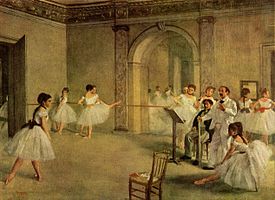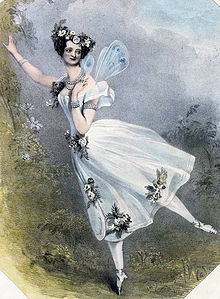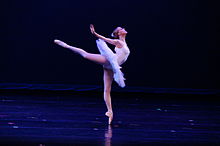- Classical ballet
-
 Painting of ballet dancers by Edgar Degas, 1872.
Painting of ballet dancers by Edgar Degas, 1872. Main article: Ballet
Main article: BalletClassical Ballet is the most formal of the ballet styles, it adheres to traditional ballet technique. There are variations relating to area of origin, such as Russian ballet, French ballet, British ballet and Italian ballet. The Vaganova method, named after Agrippina Vaganova, the Cecchetti method, named after Enrico Cecchetti and the Bournonville method, named after Auguste Bournonville are Russian, Italian and Danish respectively and derive from the original French method.
Classical ballet is best known for its unique features and textures, such as pointe work, turn-out of the legs, and high extensions; its graceful, flowing, precise movements; and its ethereal qualities.
Contents
History of Ballet
Main article: History of balletDevelopment as an art form
Technique
Ballet, especially classical ballet, puts great emphasis on the method and execution of movement.[1] A distinctive feature of ballet is the continuous outward rotation of the thighs from the hip, referred to as "turnout". The foundation of the dance consists of five basic positions, all performed with the turnout. Young dancers receive a rigorous education in their school's method of dance, which begins when they are young and ends with graduation from high school. Students are required to learn the names, meanings, and precise technique of each movement they learn. Emphasis is put on building strength mostly in the lower body, particularly the legs, and the core (also called the center or the abdominals) as a strong core is necessary for all movements in ballet, especially turns, and on developing flexibility and strong feet for dancing en pointe.
Training
There are at least seven styles of training in classical ballet, the most common being Vaganova method (Russian), Cecchetti method (Italian), Royal Ballet School and Royal Academy of Dance methods (English), and Balanchine method (American). The techniques found in classical ballet are a framework for many other styles of dance, including modern ballet and contemporary ballet.
For women, the typical ballet class attire includes pink, blue, or flesh colored tights and a leotard (which can come in various colors and styles), with an optional short wrap-skirt. For men, the typical class attire includes tights along with a form-fitting shirt or leotard. Dancers wear soft technique shoes, often called flats during their classes. The female dancers usually wear pink or beige flats while the men wear black or white flats. Often, leg warmers (knitted tubes that vary in length from just long enough to cover the ankle to long enough to cover the entire leg) are worn during the early part of a class to protect the dancer's muscles until they become warm. During ballet class, it is usually required that women restrain their hair in a bun or other style which keeps the hair flat against the head and off the neck. The purpose of the customary dance class attire and hair style requirements is to allow the dancer freedom of movement and allow teachers to evaluate the alignment and technique of the dancer.
Once the foundation of basic technique has been laid, women begin to wear pointe shoes while men continue to wear soft shoes and learn more advanced jumps and turns. The age at which dancers start pointe work varies from student to student. Strength is paramount in being able to wear pointe shoes for extended periods of time. Premature wearing of pointe shoes or insufficient training can result in serious injuries and/or disabilities in later life. Generally speaking, many studios do not allow students to take pointe class until at least 11 years old, assuming she has reached adequate skill and strength for her level. Any younger than eleven, even with strong physique and technique, the bones in a student's feet will mold and conform to the pointe shoe and the girl's feet will likely be disfigured in structure.
Method
Although there are regional variations, the 'rules' and movement vocabulary of ballet remain the same throughout the world. The different training techniques of ballet are designed to produce a different aesthetic quality from a student. This is particularly noticeable in the high extensions and dynamic turns of Russian ballet, whereas Italian ballet tends to be much more grounded, with a focus on fast intricate footwork . For example, the Tarantella is a well-known Italian folk dance, which is believed to have influenced Italian ballet.
The most notable ballet methods are named after their originator. For example, two prevailing systems from Russia are known as the Vaganova method after Agrippina Vaganova, and the Legat Method, after Nikolai Legat. The well-known Cecchetti method is based on technique developed and taught by the Italian dancer Enrico Cecchetti (1850–1928). Another European system, based on the teaching methods of the Frenchman Auguste Vestris, was that developed in Copenhagen by August Bournonville (1805–1879). The system is taught chiefly as a tradition in Bournonville's own country of Denmark.
Technique
Ballet, mostly classical, puts a great amount of emphasis on the execution of movement and the method.[1]
The feature of ballet is the outward rotation of the thighs from the hip. The foundation of the dance is of five basic positions, all performed with the turnout. Most young dancers receive a very strict and rigorous education in their school's method of the dance, which begins when they are young and ends with graduation from high school. Students are required to learn all the names, meanings (most), and last but not least precise technique of each movement which they learn. Emphasis is the building or putting on building strength mostly in the lower body (particularly the legs and the core which are also called the center or the abdominals) as a strong core is necessary for many movements in ballet mostly turns, and on developing flexibility and strong feet for dancing en pointe.
Illusion of flight
Main article: Ballon (ballet)To perform the more demanding routines, a ballet dancer appears to defy the laws of physics. Basic physics and understanding of human perception provide insight into this. A high level of physical fitness is required.
For example, during the grand jeté, the dancer may appear to hover. Physically, his/her center of mass describes a parabola, as does any projectile. Observors have limited ability to reckon center of mass when a projectile changes its configuration in flight. To do this the dancer extends their arms and legs, which camouflages the fall and leads the audience to perceive the dancer is floating.[2][3][4]
A Pas de Chat (step of the cat) creates a similar illusion. The dancer starts from a plié, then during the ascending phase of the step, quickly lifts each knee in succession with hips turned out, so that for a moment both feet are in the air at the same time, passing each other. For a moment, the dancer appears suspended in air.
The landing must be performed carefully, the dancer bends at the knees (plies) and rolls the foot from toe to heel. For artistic as well as safety reasons this technique must be taught by a qualified instructor.[5][6][7]
See also
- The Sergeyev Collection
- Ballet styles
- Classical ballet
- Contemporary ballet
- Neoclassical ballet
- Ballet technique
- French ballet
- Russian Vaganova method
- Italian Cecchetti method
- En pointe
- Glossary of ballet
- Ballet (music)
- Ballet company
References
Notes
- ^ a b Kirstein (1952), pp. 6-7, 21.
- ^ "Physics of Dance". http://web.hep.uiuc.edu/home/g-gollin/dance/dance_physics.html.
- ^ "Simulation of the Airborne Phase of the Grand Jete in Ballet" (PDF). http://www.health.uottawa.ca/biomech/lab/docs/abc5_gr.pdf.
- ^ "The Grand Jete. Illusion of Floating.". http://www.phys.washington.edu/users/jeff/courses/ken_young_webs/208A/grand-jete.html.
- ^ "Analysis of the Aerial and Landing Phases of the Grand Jete" (PDF). http://www.health.uottawa.ca/biomech/lab/docs/isbs22_tt.pdf.
- ^ "Tips for Improving Leaps". http://www.westfieldymcagymnastics.com/gymtips.html.
- ^ "Learning to leap; Tips and Technique". http://www.dance.net/topic/5251050/1/Jazz-Beginners/Learning-to-leap-Tips-and-Technique.html&replies=3.
Sources
- Anderson, Jack (1992). Ballet & Modern Dance: A Concise History (2nd ed. ed.). Princeton, NJ: Princeton Book Company, Publishers. ISBN 0-87127-172-9.
- Bland, Alexander (1976). A History of Ballet and Dance in the Western World. New York: Praeger Publishers. ISBN 0-275-53740-4.
- Chantrell, Glynnis, ed (2002). The Oxford Essential Dictionary of Word Histories. New York: Berkley Books. ISBN 0-425-19098-6.
- Kirstein, Lincoln; Stuart, Muriel (1952). The Classic Ballet. New York: Alfred A Knopf.
- Lee, Carol (2002). Ballet In Western Culture: A History of its Origins and Evolution. New York: Routledge. ISBN 0-415-94256X.
External links
Ballet General information History of ballet · Ballet timeline · Glossary of ballet · List of ballets · Ballet music · Ballet company · Ballet Portal
Ballet by genre Ballet by region Ballet technique Ballet apparel Ballet schools Elmhurst School for Dance · English National Ballet School · John Cranko School · La Scala Theatre Ballet School · Moscow State Academy of Choreography · The National Ballet School of Canada · Royal Ballet School · Royal Winnipeg Ballet School · School of American Ballet · Vaganova Academy of Russian BalletBallet companies American Ballet Theatre · Australian Ballet · Paris Opera Ballet · Birmingham Royal Ballet · Bolshoi Ballet · English National Ballet · Joffrey Ballet · Mariinsky Ballet · National Ballet of Canada · New York City Ballet · The Royal Ballet · Royal Danish Ballet · Royal New Zealand Ballet · Royal Swedish Ballet · Royal Winnipeg Ballet · San Francisco Ballet · La Scala Theatre Ballet · Stuttgart BalletCategories:
Wikimedia Foundation. 2010.



